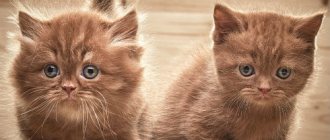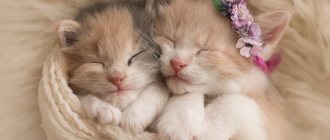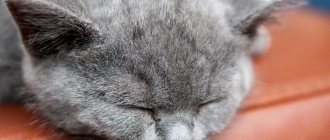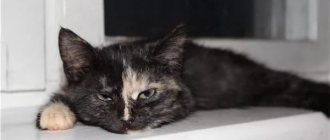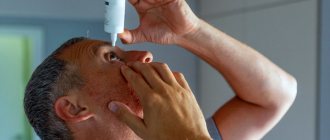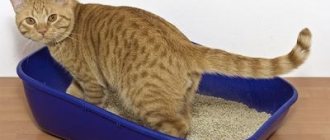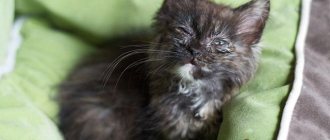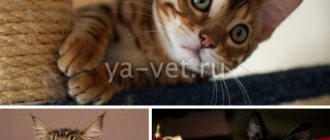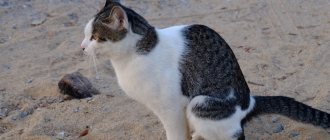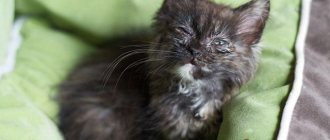Save the article:
Unfortunately, diarrhea in a kitten is by no means a rare phenomenon and indicates disturbances in the digestive process. But there are also more significant reasons for the occurrence of diarrhea in the smallest furry in the house: it is better to know what could cause such a disorder of the gastrointestinal tract and promptly eliminate the causes that are harmful to the baby’s health.
Symptoms of diarrhea in kittens
global $ads_google; //data-ad-slot=”2475549904″ $ads_google = empty($ads_google) ? false : true; ?> if ($ads_google == false) {?>
$ads_google = true; ?> } ?>
It is not difficult to determine that a kitten has diarrhea. This is necessary in order to take health measures in a timely manner and prevent serious consequences for the life of the young cat.
So, we determine loose stools in kittens:
- the kitten’s state can easily be considered depressed;
- there are problems with appetite, more often it simply doesn’t exist;
- if diarrhea is prolonged, the animal’s weight will decrease;
- frequent bowel movements;
- dehydration (when taken by the scruff of the neck, the skin then straightens out for a long time);
- loose stools, possible admixtures of undigested food;
- your tummy may be bloated.
In general, it is clear from the baby that he is experiencing discomfort, so it is important to find out what could cause such a disruption of the gastrointestinal tract.
If your cat has a hard belly rather than a soft belly
Anyone who owns a cat is well aware that a cat has a particularly soft part of its body: its belly, which is unsurprisingly called “soft.” Some also call it a "pouch". This area of the body is nothing more than a growth that cats have in the lower abdomen. Although a cat's body is inherently elegant, agile and fit, this area always remains the softest and most saggy: this is not a disease or a malformation.
When a cat undergoes spay surgery, the empty space in the gonads or ovaries causes a hormonal decline. This way the tissues relax and the stomach appears softer. Of course, this is not the fat that remains attached to your belly after a serious diet. But then why can a cat have a hard and often swollen belly? Answers in the next paragraph.
© shutterstock
Main causes of diarrhea
Diarrhea is the rapid passage of food through the digestive tract. There are quite a few reasons for this phenomenon:
- animal experience;
- nutritional errors;
- infection;
- parasites;
- allergy;
- fur accumulated in the stomach;
- sickness and poor health.
Let's look at each reason in more detail.
The emotional state of a small animal can tell on its digestion. This may be a reaction to a change of place of residence, the appearance of a new inhabitant or guest in the apartment, and especially gentle cats even react to a change in the tray and sleeping place that has become familiar.
Errors in diet planning definitely cause damage to health. Most often, owners worry about their pet and desperately overfeed it, especially by abusing cat treats. This also includes the kitten eating prohibited foods, such as smoked meats, spoiled food, or changing food.
Infections in the form of panleukopenia, coronavirus enteritis, toxoplasmosis and calicivirus can easily overcome a baby. But the stool will not tell you what exactly is to blame here; if an illness is suspected, the kitten is taken to the veterinarian.
The appearance of parasites in the body is also not uncommon. They can be brought in by people with food and land. Gradually there will be more and more of them, and the kitten will develop diarrhea as a reaction to intoxication of the body. Tape tapeworm and coccidia are especially guilty.
Allergies are also considered among the probable causes of loose stools. It could be your own fur or other irritants; it makes sense to visit a specialist at the veterinary clinic. Particular attention should be paid to kittens of the Somali cat, Pixie-Bob, Norwegian Forest, Maine Coon, Ragdoll: these long-haired beauties tend to swallow clumps of their fur.
When there are health problems, bowel dysfunction is the first thing that appears very often. These are viruses, chronic liver and kidney diseases, reduced immunity. This also includes diseases of the gastrointestinal tract, erosion and tumors.
If you have problems with the gastrointestinal tract, mucus can often be found in the stool.
Poisoning and antibiotic treatment are also factors that affect the quality of a kitten’s stool. First, the intestinal microflora is restored, and then it is observed whether the loose stools have disappeared.
Other causes of belly bumps
The appearance of bumps in cats is not always caused by benign or malignant neoplasms. Similar signs may occur with inflammation of the skin, the appearance of lipomas and hernias.
Inflammation of the skin
Small and large bumps throughout the animal’s body are characteristic of the following cases:
- Furuncle. The inflammatory process begins in the hair follicle. As it develops, the cone increases in size. If left untreated, the soft swelling will rupture. Purulent contents are released from it. And at the site of the boil an ulcer forms.
- Carbuncle. Dense inflammation on the skin of an animal. It may appear on the side and other parts of the body. Develops to large sizes. Small blisters of pus form on the surface.
- Folliculitis. It manifests itself in the form of a small nodule on the body of a kitten or an adult animal. Over time, it turns into a vesicle with purulent contents.
- Abscess. This is a cavity with pus, which is located above the skin.
- Phlegmon. Red dense swelling on the cat's body. When light pressure is applied, a squelching sound is characteristic.
Wen (lipomas)
Wen look like bumps under the skin. With the normalization of lipid metabolism and the introduction of a balanced diet, these formations can resolve on their own. Only a veterinarian can distinguish a lipoma from cancer. This will require a biopsy, ultrasound and x-ray.
How long can diarrhea last?
global $ads_google; //data-ad-slot=”2475549904″ $ads_google = empty($ads_google) ? false : true; ?> if ($ads_google == false) {?>
$ads_google = true; ?> } ?>
Duration of diarrhea with a frequency of 2-3 times a day can very quickly lead a kitten to severe dehydration. Replenishing lost fluids at home can be challenging. Duration of up to three days is critical; it is better not to wait so long and consult a doctor.
The kitten has a bloated belly and diarrhea
Bloating with diarrhea is formed due to flatulence, less often due to overeating. This combination is caused by errors in the preparation of the kitten’s diet, which needs to be fed properly. Tender stomachs simply cannot digest adult food! As a result, food accumulation occurs, indigestion leading to diarrhea, flatulence and vitamin deficiency.
Worms also cause bloating; if deworming is not carried out, then this is the first thing that should come to the owner’s mind. If they exist, and the animal is not spared from such “neighbors,” then the death of the baby is quite likely. It is better to carefully study the material about parasites in cats and kittens, and not return to this problem.
If the kitten's tummy is swollen, it is better to go to the veterinarian, who will rule out serious illnesses and advise about loose stools.
What to do
If the cause is overeating, then it is important to adjust the diet itself and the portion size.
When the cause is parasites, then such a baby needs a certain dose of medication, and it should be agreed upon after examination at a veterinary clinic with a specialist. Self-treatment is fraught with violations in dosage and incorrect approach to the treatment regimen.
Flatulence appears as the kitten grows; if the diet is improved, the problem will quickly go away. The combination of loose stools and flatulence is painful; it is better to help the baby with activated carbon or enterosgel, while reviewing the diet. The coal tablet should be cut into 4 parts and mixed with water.
Causes of regurgitation
First, let's look at the causes of regurgitation, which occurs in most babies and should not cause concern to parents:
- Immaturity of the digestive system
. In an adult, a special muscular valve or sphincter is located between the stomach and esophagus. It's called Cardia. This valve prevents food from being thrown back into the esophagus. In babies under six months it is not sufficiently developed. Therefore, any contraction of the stomach walls causes regurgitation or reverse reflux. This is the absolute norm for all children. Most often, by the age of 6 months everything goes away. In rare cases, it continues until the age of one. - Binge eating
. Babies do not always eat as much as they need; they often eat as much as they can fit. And the body already regulates the required amount of food by regurgitating excess. This reason for regurgitation is typical for artificial babies. The mixture comes through the nipple more easily than from the breast. The baby eats faster than he feels full. That's why overeating happens. - Swallowing air with food
. In this case, the air comes back out along with the milk, and the baby spits up. - Gas and colic
. They can also cause reflux. Air bubbles press on the walls of the intestines and stomach and promote the return of food to the esophagus. - Increased nervous excitability
. When the baby is worried, the walls of the stomach begin to contract and the milk consumed is returned.
Alarming symptoms that are a reason to immediately consult a doctor are most often accompanied by disturbances in weight gain, since the milk eaten is not absorbed by the body:
- Frequent regurgitation in a fountain
. It may be an indicator of lactase deficiency - in other words, the inability to digest milk. Read more about lactase deficiency in our article. Fountain burping can also occur due to improper development of the baby's digestive system. - Regurgitation of milk that is yellowish or greenish in color
. May be an indicator of an infectious disease. Or occur as a result of the reflux of bile into the stomach. The baby will most likely behave restlessly, since bile irritates the walls of the stomach.
But how can you determine the cause of reverse reflux? In fact, this is not necessary! There is only one indicator that is important to monitor - weight gain. If your baby is gaining weight normally and you are not experiencing any alarming symptoms, then there is no reason to worry. The spitting up will stop on its own as the baby gets older.
Regurgitation after formula feeding
This is not to say that regurgitation after formula feeding is more common than with breast milk. However, it happens that the mixture is not suitable for the baby due to the characteristics of the composition. In any case, we remember that if profuse regurgitation occurs like a fountain after the mixture, then there is an indication to consult a doctor. And this must be done immediately.
The pediatrician will determine the cause. And if it is in the mixture, then he will prescribe a different or special anti-reflux mixture.
The kitten has diarrhea with blood and/or mucus
If it seems that a kitten’s diarrhea is due to an incorrect diet, then mucus in the stool is an indication that this opinion is wrong. The first step is to understand whether parasites are bothering your pet. It’s hard to believe how many parasites can torment cats, it’s a whole dominance of dangerous neighbors in the body!
If mucous diarrhea is accompanied by vomiting, drowsiness, and apathetic behavior, then there is a possibility of intestinal inflammation.
Bloody diarrhea is less common in kittens. If there is blood in the stool, there are probably several reasons for its appearance:
- poor vascular permeability;
- erosion, intestinal ulcer or perforation.
If the blood comes out directly from the stomach or small intestine, then the diarrhea will be red, and hemoglobin will not be digested in this case. When these are streaks of blood, it means that the problem happened in the large section or in the last segments of the small intestine.
What to do if you have bloody diarrhea
To treat bloody diarrhea in a small kitten, you need to use a diet, as well as eliminate all the symptoms and the causes that caused them. All this happens at the same time.
global $ads_google; //data-ad-slot=”2475549904″ $ads_google = empty($ads_google) ? false : true; ?> if ($ads_google == false) {?>
$ads_google = true; ?> } ?>
It is advisable to donate feces for testing - they will tell you exactly what the reason is.
It is important to understand that losses of potassium and sodium during diarrhea are dangerous, as they lead to disruption of water-salt metabolism, which increases diarrhea. It turns out to be a vicious circle. Requires the introduction of Regidron, Hydrovit, Hydrolyte.
The kitten's diet begins on the first day of treatment, primarily by fasting for no more than 12 hours. After this time, the kitten must eat. During treatment, your child should drink clean boiled water at any time.
When the hunger strike period has passed, you need to start complementary feeding with boiled rice porridge, then add boiled chicken or beef. If all is well, you can add a hard-boiled egg.
When the owner is convinced that the diarrhea has passed, you need to feed the kitten with fermented milk products and Bifidumbacterin.
Natural cause
A cat may have a tight belly for natural reasons. So, in late pregnancy, due to a serious enlargement of the uterus, tension in the peritoneal muscles occurs. This phenomenon is necessary to prevent injury to the kittens. In this case, the cat does not require treatment, since this condition is natural.
The abdominal wall becomes especially hard before lambing, since at this moment all the muscles begin to tense, preparing the body for the birth of kittens. After their birth, the abdomen may remain hard for several hours, thus causing muscle spasm, which is a consequence of severe overload.
Diarrhea with vomiting
When, as a result of reflection, the contents of the stomach are thrown out through the oral cavity, we call it vomiting. It is evidence of irritation of the central nervous system - the signal came there from the stomach or intestines, most likely the problem is inflammation, which will be indicative in the presence of concomitant diarrhea.
When in doubt, you need to look at the animal carefully: coughing is different from vomiting. When coughing, the chest works, this is a rapid movement, and when vomiting, spasms of the abdominal wall are visible, the back can also arch, the action can be prolonged and repeated.
What to do for diarrhea and vomiting in kittens
First aid for diarrhea with vomiting is provided at home by the beloved owner. Vomiting greatly depletes the kitten’s strength; in combination with diarrhea, it quickly contributes to the disruption of the water-salt balance, which leads to recurrence of vomiting and loose stools, and it will not be easy to get out of the vicious circle.
The first step is to stop the vomiting. Metoclopramide with a dosage of 0.2-0.4 mg/kg helps with this; the drug can be used 3-4 times a day. This product is in the form of a solution for subcutaneous injection or tablets.
Symptomatic treatment is also carried out with tablets and solutions of ondansetron and dolasetron. Ondasetron is given twice a day at a rate of 0.5 mg/kg. Dolasetron is dosed at 0.6-1 mg/kg and given once.
Vomiting will be stopped by prochlorpromazine and chlorpromazine at a dosage of 0.1-0.5 mg/kg three times a day. Then they look for the cause of diarrhea and eliminate it by carrying out symptomatic therapy.
If the diarrhea is black
global $ads_google;
//data-ad-slot=”2475549904″ $ads_google = empty($ads_google) ? false : true; ?> if ($ads_google == false) {?> $ads_google = true; ?> } ?> Mustard-colored liquid feces in kittens is normal, but the black color called “melena” is not at all present. This is evidence of problems in the body, unless, of course, there are preparations containing iron in the diet, or there is an excessive amount of raw meat or blood meal.
The list of diseases associated with red-black diarrhea is long; you cannot cope with this on your own; consult a doctor.
The main reasons for the appearance of lumps on the stomach of cats
Lumps under the skin on the abdomen in cats are most often benign (mastopathy) and malignant neoplasms (cancer). The first option is characterized by enlargement of the mammary glands.
Normally, it is observed in nursing cats, in other cases it is considered a pathology. It starts with small lumps and without proper treatment can develop into cancer.
The second option is the most common and dangerous. It manifests itself as lumps on the cat’s stomach in the area of the nipples. In some cases, slight lethargy of the animal is observed. After some time, these bumps grow, turn purple and bleed.
The kitten has yellow diarrhea
If the diarrhea is yellow in color, then the kitten’s feces move too quickly towards the exit, but there may be enough reasons for this, namely the presence of:
- infections;
- worms;
- allergies;
- lactose intolerance.
Normally, bile with yellow bilirubin should enter the intestines. As stool passes through the intestines, digestive enzymes cause bilirubin to turn into brown stercobilin. With diarrhea, peristalsis is disrupted and increased, so the transformation process does not occur.
In addition, the kitten may have jaundice, in which case there is too much bilirubin in the stool, which is why it is yellow.
How to treat
Here's how to help a child with diarrhea of this color: first you should take a blood test and check the liver. At the same time, the cat’s diet is adjusted to normalize stool quality.
Kittens are not allowed out of care at first, because this causes dehydration, which can end in the most disastrous way. The water should be nearby, clean and fresh! Drink only boiled water to avoid the development of secondary infection.
Each act of defecation should end with washing the base of the tail with soapy warm water - bilirubin can irritate the skin. And if helminths are added to everything, then in this way the owner washes off their eggs.
If you are overfeeding your cat, you can add pumpkin puree to the food, the dosage is a teaspoon, three times a day.
Vaccinations for diarrhea cannot be carried out, even if the calendar date has come!
Foul diarrhea
If the cat was treated with antibiotics, then there may be a side effect in the form of foul-smelling diarrhea. This is an indirect sign that the medicine was chosen incorrectly. The veterinarian should decide this.
Sometimes there are no antibiotics, but the diarrhea still smells bad. This means that the food is of poor quality; you need to help the baby with a little fasting.
Treating a kitten for diarrhea at home
Let's talk about those cases when you can carry out treatment and adjustments at home yourself.
Treatment of newborn kittens
The normal state of the kittens’ body allows the intestines to function as expected, therefore, their feces can be mushy or shaped, yellow or mustard in color. Defecation can be seen up to 4 times a day. From this it follows that diarrhea will be considered liquid, semi-liquid and foamy consistency with a different color palette: black, red, green feces, as well as feces with the presence of gray mucus, helminths and their eggs.
If the cause is a bacterial infection, then you need to take antibiotics, and if the infection is viral, then, accordingly, an antiviral drug.
Worm infestation is treated with anthelmintics, allergies with antihistamines.
What to feed newborn kittens
Symptoms in newborn kittens increase quickly; it is not always possible to immediately seek qualified help - first aid is needed immediately. The cat needs to be given the drug “Smecta” or “Enterosgel”, they will remove toxins.
In case of severe stool upset, you can treat your baby with loperamide at the rate of 0.1 mg per 1 kg of weight.
If there is noticeable dehydration, you need an injection under the withers of Ringer-Locke drug or saline solution. In total, pour no more than 3 ml.
Useful information: How to give an injection to cats
Treatment of a one-month-old kitten
Symptoms of diarrhea in a one-month-old baby will include frequent loose bowel movements with an uncharacteristic odor and color. In the absence of high body temperature or pathological impurities in the stool, you can be treated at home, but otherwise you should take the patient to the doctor.
The first step is to remove from the menu the food that supposedly became the catalyst for diarrhea. You will have to remember what the baby ate in the last days before the illness. Especially if something new was introduced into complementary foods.
global $ads_google; //data-ad-slot=”2475549904″ $ads_google = empty($ads_google) ? false : true; ?> if ($ads_google == false) {?>
$ads_google = true; ?> } ?>
Often, diarrhea at this age is only a reaction to the abrupt weaning of the mother cat with a change to fermented milk food, or cow's milk. Food for adult cats will cause the same reaction.
You should not feed your little cat food from the owner’s table, namely meat, fish, sausage, which is what you usually want to pamper your pet with. At this age this shouldn't happen at all.
What to feed kittens at 1 month
You can make the cat starve for up to 12 hours, and then they begin to feed the rice broth, namely the liquid in which it was boiled. You can give your baby Smecta and Enterosgel, but it is important to follow a diet.
It is important to provide the young body with peace: do not insist on games or frighten it with loud sounds. Stress is not the best help at this time.
Treatment of kittens at 2 months
When a kitten is two months old and suffers from diarrhea, this is often due to a change of place of residence - older cats are given to new owners. But they, in turn, are not very well prepared for such responsibility and have not clarified for themselves all the subtleties of the issues of feeding a pet.
The first thing that should come to mind is stress. For a small cat, this is a change from the familiar world to a new environment, new people, so the body can react in a similar way. It is important to make the new tenant feel that he will be comfortable, calm and happy here.
You can immediately take the baby to a cozy corner, where he himself would begin to master his future possessions. Adaptation will happen faster, diarrhea will be quickly forgotten.
What to give a kitten at two months
If the reasons are more significant, then you can relieve intestinal spasms with papaverine. You also need to thoroughly find out what diet the previous owners followed - if a different diet is planned, then the transition to it should be as smooth as possible.
Diarrhea in three month old kittens
Three-month-old male cats are already bundles of energy and strength, but diarrhea can overtake them too. The reasons may be overeating, eating dangerous substances, or the process of deworming.
Naturally, each body can react in its own way to getting rid of parasites, the main thing is that the loose stools are not prolonged.
Treatment of diarrhea in kittens at 4 and 5 months
When a cat reaches four months, he may already suffer from diarrhea, like his adult counterparts.
Stress can be cited as a cause if:
- a visit to the veterinary hospital took place;
- new pets have settled in the house;
- children showed excessive activity in games;
- there are fears of loud objects and sounds;
- a move to a new place of residence took place;
- it was a long road;
- the menu has changed;
and also if there are diseases of the gastrointestinal tract.
global $ads_google; //data-ad-slot=”2475549904″ $ads_google = empty($ads_google) ? false : true; ?> if ($ads_google == false) {?>
$ads_google = true; ?> } ?>
For 4-5 month old cats, individual treatment is prescribed, but first an examination is carried out to identify significant health-related causes.
Mammary cancer
Lumps in the abdominal area of cats in most cases are a malignant tumor. Animals older than 5–6 years are susceptible to this disease. The peak occurs between the ages of 7–10 years.
Causes
The exact cause of cancer in cats has not been established. Only the factors that provoke its development have been identified. In the first place are hormonal disorders that develop for the following reasons:
- Physiological processes, the first of which is puberty. This applies to changes in the cycles of estrus, pregnancy and rest.
- Artificial hormonal imbalance. Caused by taking hormonal pills to suppress estrus.
Important! Oriental and Siamese cats are more susceptible to cancer than others.
The development of a malignant tumor is provoked by factors such as the age of the cat, hereditary or breed predisposition, low-quality nutrition, and environmental conditions.
Tumor stages
Breast cancer is divided into four stages. According to the TNM classification, stages I and II have a favorable prognosis. Such animals live for about 5 years. And after the first operation, their complete recovery can occur. Stage III involves surgical treatment and chemotherapy.
Stage IV is characterized by the presence of metastases in internal organs. It cannot be treated surgically, only chemotherapy can be used.
Important! Even an experienced veterinarian cannot determine the life expectancy of a cat diagnosed with cancer. It depends on the stage of the disease, the animal’s immunity and the method of treatment.
Based on their shape, cancerous tumors are divided into nodular and diffuse. In the first case, surgery is performed, and in the second, treatment begins with radiation or chemotherapy, followed by surgery.
Clinical signs
Symptoms of breast cancer make themselves felt during the transition from stage III to stage IV. During this period, the pet’s condition, its appearance and skin deteriorate. Single or multiple lumps under the skin may be palpable. Then the tumor grows.
Main symptoms of breast cancer:
- inflammation of tissue in the tumor area;
- pain during palpation of the pet’s chest and tummy;
- increased body temperature;
- pronounced size of the tumor;
- refusal of food.
Signs of a malignant tumor are similar to other pathological changes in the mammary glands. An accurate diagnosis will be made by a veterinarian based on the diagnostics performed.
Diagnostics
A veterinarian can determine why lumps appear on a cat’s mammary glands after conducting diagnostics. And she means:
- X-ray;
- ultrasonography;
- magnetic resonance imaging;
- computed tomography;
- histology.
Important! Inaccurate collection of a biosample for histological examination often leads to the development of metastases and tumor growth.
To determine the condition of the body, a general blood test is performed. It will show the presence of secondary infections and the degree of the inflammatory process.
Treatment methods
Most diagnosed cases require resection of tumors. This treatment involves three main stages:
- Removal of the tumor and part of nearby tissue.
- Preventing the development of metastases by resection of lymph nodes.
- Carrying out chemotherapy. Its action is aimed at preventing relapse in the cat and stopping the tumor process.
During surgery, it is recommended to remove the uterus along with the appendages. Such a radical solution will minimize the reappearance of the tumor and possible postoperative complications.
Prevention measures
The main preventive measure is early sterilization of the cat. The procedure is carried out before the onset of puberty and the appearance of the first heat. If you plan to get offspring from a pet, the owner must provide her with healthy, nutritious nutrition and avoid taking hormonal pills.
Medicines and dosage for diarrhea in a kitten
There is a list of medications for loose stools tested by veterinarians and cat lovers.
| Medicine | Application |
| Activated carbon | For diarrhea without serious symptoms. If the baby’s condition is good, then one activated carbon will probably be enough as a medicinal component. |
| Smecta | Secures the chair well. It is safe for the baby's health, but the dosage must be observed correctly. |
| Loperamide | Not the very first remedy, since this is a medicinal product aimed at human use. Dosage accuracy is important. |
| Enterosgel | This is also a drug developed for people, but it also turned out to be useful for the cat’s body. Enterosgel is literally an ambulance for getting rid of toxins during diarrhea, infections, and poisoning. It is best to give the medicine at the first symptoms of the disease. |
| Antibiotics | There are various drugs that inhibit the development of the bacterial sphere; glycopeptides are popular groups; aminoglycosides; chloramphenicol. Only a veterinarian can prescribe such a remedy, indicating the dosage and regimen. |
| Enterofuril | The medicine is not given to the cat until 1 month, after which it will seem magical, because diarrhea can go away in a short time. The suspension is recommended for use by kittens as a more moderate remedy for such a small body. |
How to reduce spitting up
It is not possible to completely get rid of the natural process of returning food, but you can make this process easier for the baby and parents.
- Carry your baby upright after feeding. This way, the air he swallowed during feeding will come out faster.
- Make sure that the baby covers the entire circumference of the nipple. Then air will not penetrate when sucking.
- Use anti-colic nipples when bottle feeding. They are designed to keep air out.
- After feeding, do not entertain the baby, let him be alone for a while.
- Try feeding for a little less time to prevent overeating.
- Give your baby a pacifier before bed to stimulate digestive activity for a while after eating.
- Provide your baby with more movement: exercise, massage, swimming, tactile contact, walks in the fresh air. So that the muscular system develops more actively. All internal organs will develop along with it.
There is no medicine that will reduce regurgitation. Because this is not a disease, it is either a symptom or a natural process.
The only thing that can affect the amount of food returned is the use of anti-colic drugs, which reduce gas formation in the intestines. Their use is justified only if the baby is tormented by gas. Pay attention to the Israeli drug for colic Simicol, which is suitable for infants from birth.
What to feed a kitten with diarrhea
A hunger strike is a hunger strike, but you still need to feed the baby something. After a 12-hour break in nutrition, you need to start giving the baby food. If the kitten is small and very weak, you will have to feed it with a pipette or from a bottle.
The main task will be to prevent dehydration!
The transition to a normal diet (healthy!) is carried out gradually: you need low-calorie, low-fat food. It will be possible to feed the cat chicken broth, kefir, boiled eggs, rice porridge, and minced chicken, but not all at once on the same day.
If the condition worsens, the animal is taken to a doctor. If recovery is noticeable, then kefir is included in the diet. The diet is not changed for a while, only gradually adding other foods. Milk is completely excluded, as is fried, smoked, and fatty milk.

